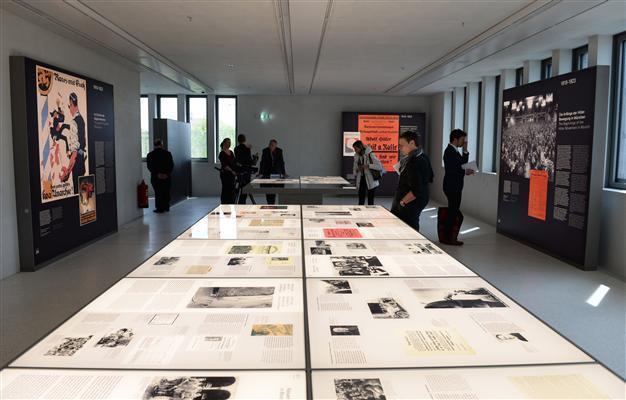Long-delayed Nazi museum opens in Munich
MUNICH – Agence France-Presse

Visitors look around a part of the new Nazi museum in Munich, southern Germany, on April 29, 2015. AFP Photo
Munich has opened the Documentation Center for the History of National Socialism, a museum on the former site of the Nazi party headquarters, in a long-delayed reckoning with the German city’s status as the “home of the movement.”The inauguration coincided with the 70th anniversary of the “liberation” of Munich by U.S. troops at the end of World War II and Adolf Hitler’s suicide committed the same day in a Berlin bunker.
Ageing American veterans and Holocaust survivors joined political leaders at a solemn ceremony for the new museum, a modern white cube built among a few surviving neo-classical buildings.
Museum director Winfried Nerdinger admitted that it had taken Munich too long to face up to its toxic legacy as the birthplace of Hitler’s party, a fact long shrouded in shameful silence.
“Munich has had a harder time with this [history] than all the other cities in Germany because it is more tainted than any other city,” said Nerdinger, the son of a local resistance member.
Mayor Dieter Reiter insisted Munich was ready to “face up to its Nazi past.”
As 30 neo-Nazi demonstrators gathered outside behind security barriers alongside a larger group of counter-protesters, Reiter said those who questioned German democracy showed why such a museum was needed “here and today.”
The Documentation Center for the History of National Socialism examines how Munich, which prided itself on its culture of tolerance, thriving arts scene and convivial beer gardens, could become the cradle of fascism.
The four-floor exhibition period photographs and videos documenting jackboot marches and the city’s utter destruction by Allied bombing, all accompanied by explanatory texts in English and German.
A chilling video graphic portrays the city’s Jewish community at the time as points of light, with more and more extinguished as the deportations to the concentration camps gathered pace.
Nerdinger said he had no desire to showcase the Nazi “aesthetic” at the 28-million-euro ($31-million) museum with displays full of crisp brown uniforms and giant swastika flags.
Instead, visitors see artifacts such as hand-scrawled sonnets found in the pocket of resistance member Albrecht Haushofer, who was executed just before the war’s end. Blood still stains the paper.
The German Workers’ Party was founded in a Munich beer hall in 1919, with Hitler joining the same year.
In 1920, it became the National Socialist German Workers’ Party, the only political force allowed in the country after Hitler’s rise to power.
Following the failed Beer Hall Putsch of 1923, Hitler used his subsequent trial for high treason as a platform to gain a national following.
A thwarted communist revolution and a crippling economic depression helped fuel a backlash that would turn Munich into a “hotbed of reactionary sentiment,” as the novelist Thomas Mann called it in 1926.
Here, far-right thugs found funding and legitimacy from the wide swathes of the upper middle class, which saw in Hitler a savior.
In 1930, the Nazis established their headquarters at the Braunes Haus (Brown House) in an upscale part of the city center, now the site of the museum.
Even after Hitler became the German leader on Jan. 30, 1933, in Berlin, it was in Munich that the Nazis duped European powers into signing the fateful agreement decreeing that Czechoslovakia cede the Sudetenland, and launched the Kristallnacht pogrom.
Munich was also key to the planning of the concentration camp system, with the first major prototype, Dachau, built on the city’s outskirts in 1933. Chancellor Angela Merkel will attend a ceremony Sunday marking the camp’s 1945 liberation.
The exhibition also casts a critical eye on the post-war period, with top Nazis seamlessly continuing their political careers and neo-Nazi groups mounting deadly attacks.
The museum itself had its own issues, with its opening postponed four times amid local infighting and its original director summarily sacked after she criticized Munich authorities.
















